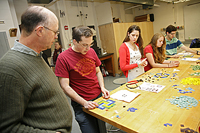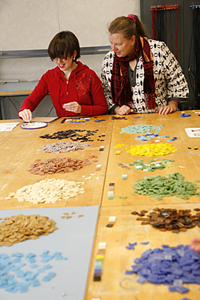Thinking like the Romans
When studying ancient Rome, do as the Romans did
 Rome, as they say, wasn’t built in a day. But it was built with great imagination and engineering brio. From elegantly simple pulleys to arches, aqueducts, and catapults, the Romans harnessed and improved all kinds of technology, building in the process one of the most modern cities in the ancient world.
Rome, as they say, wasn’t built in a day. But it was built with great imagination and engineering brio. From elegantly simple pulleys to arches, aqueducts, and catapults, the Romans harnessed and improved all kinds of technology, building in the process one of the most modern cities in the ancient world.
Dan Perl ’08, a neuroscience, biology, and psychology major, could tell you how because he helped build a small-scale version of the Pantheon’s dome, albeit out of Styrofoam blocks. He is one of forty students enrolled this semester in “Roman Technology and Art,” a course in which the students explore Roman technologies by applying modern physics.
 Perl and his classmates are learning first-hand how the ancient Romans engineered and built architectural monuments like the Pantheon and the Colosseum, Roman baths, aqueducts, mosaics, and catapults. At the same time, they are learning about Roman daily life, from art and architecture, to transportation and urban planning.
Perl and his classmates are learning first-hand how the ancient Romans engineered and built architectural monuments like the Pantheon and the Colosseum, Roman baths, aqueducts, mosaics, and catapults. At the same time, they are learning about Roman daily life, from art and architecture, to transportation and urban planning.Under the expert team teaching of professors Ann Olga Koloski-Ostrow, chair of the department of classical studies, and physicist Robert Meyer, the students are covering highlights of Roman technology from the 8th century BCE to the end of the Roman Empire in the 4th century CE, focusing particularly on the imperial period, from the 1st century BCE to the 3rd century CE.
The Romans were technologically savvy enough to astound even Meyer, whose current research interests include hyper-complex fluid systems, liquid crystals, and smart materials. He says he was amazed at how the Romans managed to import about 400,000 tons of wheat a year from Africa, mostly from Egypt, to feed one million people in the city during the first and second centuries CE.
“In our course, the students calculate how many ships this took, how many containers for the wheat were used, and other interesting facts to see the implications of a central fact like this one for other aspects of Roman culture and economics,” explains Meyer. “The Romans had ships that could carry well over 1,000 tons of wheat from Egypt to Rome, very big ships that were not surpassed in size for well over a thousand years!”
Koloski-Ostrow, a classicist who is also a leading expert on Roman water and sanitation systems, provides the “humanist” side of the lectures, while Meyer weighs in with class demonstrations and models. “His own clear teaching style explains the science behind the accomplishments of the Romans both to me and to many humanist students who would be afraid to confront it without his steady guidance," says Koloski-Ostrow.
“I love the class; it’s a really nice blend of physics and culture,” says English major Justine Root ’10.
“I like the pulleys the most because it brought the math together with reality,” explains Perl, adding, “this is a good class to see why physics is important.” The students recently devised compound pulley systems to get an idea of how the Romans were able to hoist huge and enormously heavy stones into place.
In addition to lectures and discussions, a series of afternoon labs enable the students to learn by doing, creating small mosaics, Roman arches, catapults, and of course, domes inspired by the Pantheon’s dome. In the process they are asking questions about the causes of technological change, what role technology played in Roman life and culture, and how they fulfilled needs and desires by manipulating nature.
When studying Rome, do as the Romans did, you might say.





